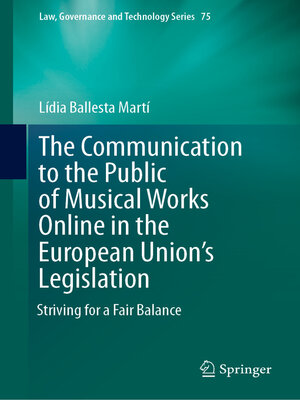The Communication to the Public of Musical Works Online in the European Union's Legislation
ebook ∣ Striving for a Fair Balance · Law, Governance and Technology Series
By Lídia Ballesta Martí

Sign up to save your library
With an OverDrive account, you can save your favorite libraries for at-a-glance information about availability. Find out more about OverDrive accounts.
Find this title in Libby, the library reading app by OverDrive.



Search for a digital library with this title
Title found at these libraries:
| Library Name | Distance |
|---|---|
| Loading... |
This book offers an in-depth analysis of EU copyright legislation and the evolving jurisprudence of the Court of Justice of the European Union (CJEU) to assess whether the current legal framework provides adequate protection for the right of communication to the public in musical works. It critically examines whether EU law strikes a fair balance between the interests of rightsholders, online music service providers, and users.
Technological innovation over the past two decades has dramatically reshaped the music industry and challenged traditional copyright norms. The emergence of digital distribution platforms and music streaming services has made it imperative to rethink how the right of communication to the public is protected in the online environment. In response, the EU introduced a series of reforms aimed at modernizing copyright rules for the Digital Single Market. But how effective are these measures? And do they truly reflect the diverse interests at stake?
This comprehensive volume explores both the international and EU legal frameworks governing the right of communication to the public. It offers a detailed interpretation of relevant legislation and landmark case law, with a particular focus on the controversial liability regime established by Article 17 of Directive 2019/790. The book also addresses enforcement challenges, including cross-border issues of jurisdiction and applicable law.
Beyond legal analysis, the book proposes thoughtful, practical solutions to help create a more equitable digital music ecosystem. Written in a clear and accessible style, it demystifies complex legal concepts for a broad readership—including IP lawyers, music creators, platform operators, policymakers, and informed users.







